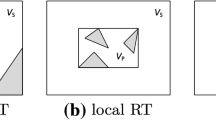Abstract
A new algorithm for space tracing with CSG modelled scenes is presented. Space is divided in an irregular fashion to fit the objects as closely as possible. For this reason, primitive minimal bounding boxes are computed. Space subdivision is achieved in two steps: partitioning in projection plane and depth partitioning. A set of 3D regions named cells are then created. A Boolean CSG tree is distributed into the cell structure to form in each cell the minimal boolean CSG tree using the relevant primitives. The searching process for the “next cell” along the ray path is performed by using a local data structure associated with each cell. The goal of this structure is to link the cells together. An improvement, named “mailbox”, for all space tracing algorithms is detailed. Results are presented for two scenes to compare this new algorithm with Roth's algorithm.
Similar content being viewed by others
References
Blinn JF (1977) Models of light reflection for computer synthesized pictures. Comput Graph 11(2):192–198
Bouatouch K, Arnaldi B, Priol T (1986) Lgrc: a language for image synthesis by ray-casting. TSI 6:475–489
Bronsvoort F, Jarke JV, Jansen FW (1984) Two methods for improving the efficiency of ray casting in solid modelling. CAD 1(16):51–55
Cook RL, Torrance KE (1982) A reflectance model for computer graphics. ACM Trans. Graph 1(1):7–24
Coquillart S (1985) An improvement of the ray tracing algorithm. Eurographics, pp 77–88
Foley JD, Van Dam A (1982) Fundamentals of Interactive Computer Graphics. Addison Wesley, London
Fuchs H (1980) On visible surface generation by a priori tree structure. SIGGRAPH'80 Conf Proc, pp 149–158 (July 1980)
Glassner A (1984) Space subdivision for fast ray tracing. IEEE Comput Graph Appl 4(10):15–22
Goldstein RA, Malin L (1979) 3d Modelling with the synthavision system. Proc First Ann Conf Comput Graph, pp 244–247, CAD/CAM system (April 1979)
Golstein RA, Nagel R (1971) 3d Modelling with synthavision simulation. Simulation 16(1):25–31
Hall AR, Greenberg DP (1983) A testbed for realistic image synthesis. IEEE Comput Graph Appl 3(8):10–20
Kajiya JT (1983) New techniques for ray tracing procedurally defined objects. ACM Computer Graphics 17(3):91–102
Kaplan MR (1985) Space-tracing, a constant time ray tracer. SIGGRAPH'85 tutorial on the uses of spatial coherence in ray tracing
Mantyla M, Tamminen M (1983) Localized set operations for solid modelling. ACM Comput Graph 17(3):279–288
Newman WM, Sproul RF (1979) Principle of Interactive Computer Graphics. Mac Graw Hill, New-York
Ousterhout JK (1984) Corner stitching: a data structuring technique for vlsi layout tools. IEEE Trans CAD 3(1):87–100
Phong BT (1975) Illumination model for computer generated images. Communic ACM 18:311–317
Requicha AA (1980) Representation for rigid solids: theory, methods, and systems. ACM Comput Surv 12(4):437–464
Roth SD (1982) Ray casting for modelling solids. Comput Graph Image Proc 18(2):109–144
Tamminen M, Koronen O, Mantyla M (1984) Ray-casting and block model conversion using a spatial index. CAD 16(4):203–208
Torrance KE, Sparrow EM (1967) Theory for off-specular reflection from roughened surfaces. J Optical Soc Am 57(9):1105–1114
Whitted T (1980) An improved illumination model for shaded display. Commun ACM 23:343–349
Author information
Authors and Affiliations
Rights and permissions
About this article
Cite this article
Arnaldi, B., Priol, T. & Bouatouch, K. A new space subdivision method for ray tracing CSG modelled scenes. The Visual Computer 3, 98–108 (1987). https://doi.org/10.1007/BF02153666
Issue Date:
DOI: https://doi.org/10.1007/BF02153666




